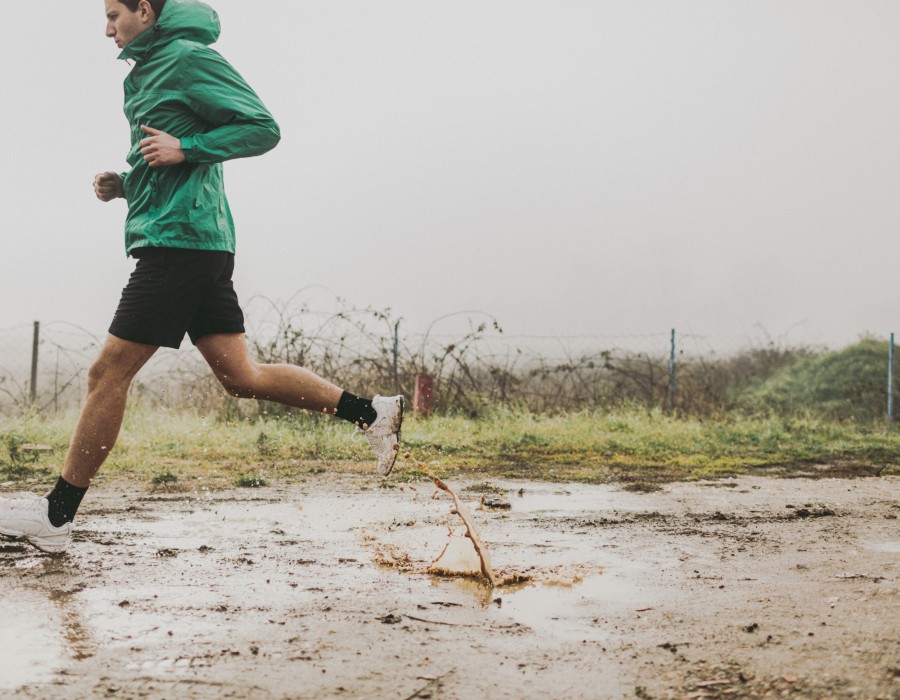Fitness and Performance
How to run in the rain

How To Run In The Rain
In the run up to summer (with April showers forecast), we wanted to encourage you not to let the wind and rain prevent you from getting out on your run! We’ve put together some key tips you may want to consider reading before you step outside. Here’s how to run in the rain…
After spending so much time at home this year, being able to go for a run outdoors has been a welcome escape. In the UK we aren’t blessed with bright sunny weather all year round… and I’m sure many of you were met with making the call, whether or not to go out in the rain.
Running in the rain doesn’t have to be miserable… as long as you are safe and comfortable, you can still enjoy your training.
Cotton is your enemy.
A highly absorbent fabric such as cotton will retain water and add to the load you’re carrying. A waterproof jacket, layering and synthetic running leggings are best at keeping the warmth in, and the rain out. Maintaining a comfortable body temperature will also help with injury prevention.
Hats don’t have to be ‘dorky’.
Wearing a running hat or sweatband will prevent the rain from running into your eyes. For some of us ladies who wouldn’t dare run without mascara, may I suggest a good waterproof version teamed with a head band… just to be safe. Panda eyes will never be cool. It might also be worth investing in a serum to help prevent frizz.
Warm-up your cockles.
Start your warm-up regime indoors. It is important to increase your heart rate and blood flow to your muscles. Start with some low impact dynamic stretches and light cardiovascular exercise. Try using a trigger point ball into the tight areas of your muscles, for example your glutes and hip flexors, to reduce tightness and ensure soft tissue flexibility. You are more susceptible to tight muscles in the cold wet weather, which can lead to muscle strains and soft tissue overload.
Sticking your tongue out in the rain isn’t enough.
Just because the sun isn’t shining doesn’t mean you won’t suffer the effects of dehydration. Ensure you take a bottle of water with you. Lactic acid can build up, which combined with low water intake, can lead to muscle cramps. You can also be more susceptible to injury such as calf tears if you aren’t sufficiently hydrated.
Watch your step.
Be careful, try to avoid big puddles. Muddy wet trainers have their issues however there can also be hidden potholes beneath. We see many ankle ligament sprains from rolled ankles, where people have miss judged puddle covered pot holes. Moist socks can lead to blisters and your feet will perspire more if they are wet. Gortex socks are often a winner.
Run in style.
Many running injuries can be avoided by shortening your stride. Stay relaxed and ensure you have a good upright running posture. Don’t try and hide your face from the rain as this can lead to trips and falls. Look at least 10 metres ahead and plan your route. Regular deep soft tissue massages and a biomechanical assessment can improve your running technique and help you hit you PBs… even in the rain!
Make sure you’re visible.
Always wear your most luminous attire. Make it a fashion statement and invest in a high-visibility jacket. They are fun to look at and are also very lightweight. Drivers are not expecting you to be out running in the rain. They are often concentrating on setting their windscreen wipers to the correct setting rather than looking out for you. Many road traffic accidents occur in low visibility weather, impact injuries can be avoided by following these simple steps.
Vas it up.
Even with the trendiest attire you can get chaffing, especially in the rain. Apply a fine layer of petroleum jelly (Vaseline) to the bits that rub. Bra lines, inner thighs and under your arms are a good place to start.
You survived.
After your run, dry out your shoes. You don’t want your trainers to grow mould. Undo the laces, pull the tongues forward and sit them close to a radiator. Do not place them directly on a heater as it can break down the rubber and the glue.
Avoid going from freezing cold weather to a boiling hot shower. Allow your body to return to room temperature. If you have any specific sites of soreness grab your ice pack or bag of peas and cover in a tea-towel and ice the area to reduce any inflammatory effects.
If you have injured yourself, whether that be through running in, or out of the rain, we can help. Simply book in to see one of our RunFit specialists for an assessment, or a standard physiotherapy assessment if you would prefer.